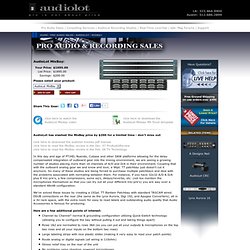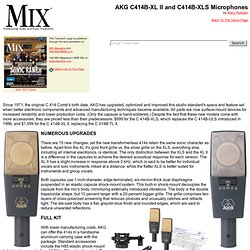

AudioLot. AudioLot has slashed the MixBay price by $200 for a limited time - don't miss out click here to download the audiolot mixbay pdf manualclick here to read the MixBay review in the Dec. 07 ProAudioReviewclick here to read the MixBay review in the Feb. 08 TV Technology In this day and age of PT|HD, Nuendo, Cubase and other DAW platforms allowing for the delay compensated integration of outboard gear into the mixing environment, we are seeing a growing number of studios placing more than 16 channels of A/D and D/A in their environment.

Coupling that with the outboard analog gear we and know and love, a 96pt. TT patchbay just doesn't cut it anymore. So many of these studios are being forced to purchase multiple patchbays and deal with the problems associated with normaling between them. We've solved these issues by creating a 192pt. Here are a few additional points of interest: Dimensions: 5.25" = height 19" = width 7.63" = depth Weight: 16 lbs. (21 lbs. shipping weight including packaging) Mixing Tips and Tricks. | Print | The First Tip: Read all the articles on this web site!

Here's one of the secrets of the mixing engineers To avoid squashing, if it doesn't sound loud enough to your ears, turn up the monitor! If you find that you've been forced to apply limiting or compression just to keep the meters from overloading, then you've been going about this backwards. Instead, turn down your individual mix levels several dB, then get rid of any compression you were using to "protect" the 2-mix. Now your mix is at a lowered meter level, so turn up your monitor gain to arrive at the same loudness--only this time it won't sound squashed. In 24-bit recording you can make a perfectly good mix that peaks between -3 and -10 dBFS with no loss of quality, in fact, with improved quality. Know thy monitors But even when you do, never be fooled.
Always mix to the highest possible wordlength Even if the source tracks are 16-bit! Another example: Electric guitar. If you have a VU meter, use it. Or Stem #1. AKG C414B-XL II and C414B-XLS Microphones. Since 1971, the original C 414 Comb's birth date, AKG has upgraded, optimized and improved this studio standard's specs and feature set when better electronic components and advanced manufacturing techniques became available.

All parts are now surface-mount devices for increased reliability and lower production costs. (Only the capsule is hand-soldered.) Despite the fact that these new models come with more accessories, they are priced less than their predecessors: $999 for the C 414B-XLS, which replaces the C 414B-ULS introduced in 1986, and $1,099 for the C 414B-XL II, replacing the C 414B-TL II. There are 15 new changes, yet the new transformerless 414s retain the same sonic character as before. Apart from the XL II's gold front grille vs. the silver grille on the XLS, everything else, including all internal electronics, is identical. Both capsules use 1-inch-diameter, edge-terminated, six-micron-thick dual diaphragms suspended in an elastic capsule shock-mount system.
Site Technique du Son.